Cambodia & Arts and Culture : The leper king or Yama, it's up to you to decide what to believe...
- Andy Brouwer

- Aug 5, 2024
- 2 min read
This statue is one of the most recognisable in Cambodian history. However, despite its fame, there is still debate about its identity, what it represents and when it was carved from sandstone and placed at the top of the Terrace of the Leper King in the great city of Angkor Thom.

For many, it is known as the statue of the Leper King, a story that tourist guides and locals have been telling for decades.
“However, for specialists, some claim that it represents Yama, the god of Death and Judgement, and that the story of the Leper King is a fictitious tale, not based on real events. Who's right?”
The statue depicts a naked male figure, with an athletic torso and plated hair, but no genitals, most likely to avoid the concept of sexuality. His face bears a moustache and two fangs protrude from his lips. He is shown seated, his right knee raised, probably carrying a mace on his right shoulder, like Yama depicted in the bas-reliefs of Angkor Wat, while his left arm rests on his leg.

Under the hot sun and as a result of intense tropical weathering, the statue has suffered from corrosion and patches of lichen, giving the impression of skin disease. In connection with its location on the royal terrace, the legend of the leper king was born and embellished by French scholars at the end of the 19th century. It also made a certain amount of sense, as there was evidence of the existence of a leper king in the distant past. However, scholars generally agree that it is Yama, as the Terrace was used for ceremonial cremations and a statue of the god of death fits the bill perfectly. It's up to you to decide which story you prefer to believe.

The statue photographed in the National Museum collection is in very good condition. Up close, it is almost perfect, but you can see a few chips on the fingers and toes and the left arm has been meticulously glued back together. It's not the most artistic image, it's actually quite simple, which may have been why it wasn't looted or destroyed for so long. It seems to have remained at the top of the terrace since it was built, probably in the 13th century, although it bears an inscription, written a century later, which reads: ‘His Majesty has made an offering on a small plate to His Majesty Dharmadhipati-adhiraja (which means Yama)’. Whoever accepts this offering will be delivered to the tortures of hell, and the mighty Buddhas of the future will not be able to free them’. This could mean that it is dated to the 14th century, although other experts suggest that it predates the Angkorian period. Only a carbon dating test of the stone will provide the answer.

In 1967, following an attempted theft and for security reasons, the statue was taken to the Angkor conservation depot, then transferred to the National Museum in Phnom Penh the same year. It was first placed in the centre of the museum courtyard before being moved to the gallery, where it stands today. In its place on the Terrace and in the museum courtyard, cement copies have been installed.
Andy Brouwer - with permission from the National Museum of Cambodia







AV在线看 AV在线看;
自拍流出 自拍流出;
国产视频 国产视频;
日本无码 日本无码;
动漫肉番 动漫肉番;
吃瓜专区 吃瓜专区;
SM调教 SM调教;
ASMR ASMR;
国产探花 国产探花;
强奸乱伦 强奸乱伦;
AV在线看 AV在线看;
自拍流出 自拍流出;
国产视频 国产视频;
日本无码 日本无码;
动漫肉番 动漫肉番;
吃瓜专区 吃瓜专区;
SM调教 SM调教;
ASMR ASMR;
国产探花 国产探花;
强奸乱伦 强奸乱伦;
代发外链 提权重点击找我;
蜘蛛池 蜘蛛池;
谷歌马甲包/ 谷歌马甲包;
谷歌霸屏 谷歌霸屏;
谷歌霸屏 谷歌霸屏
蜘蛛池 蜘蛛池
谷歌快排 谷歌快排
Google外链 Google外链
谷歌留痕 谷歌留痕
Gái Gọi…
Gái Gọi…
Dịch Vụ…
谷歌霸屏 谷歌霸屏
负面删除 负面删除
币圈推广 币圈推广
Google权重提升 Google权重提升
Google外链 Google外链
google留痕 google留痕
代发外链 提权重点击找我;
游戏推广 游戏推广;
Fortune Tiger Fortune Tiger;
Fortune Tiger Slots Fortune…
谷歌马甲包/ 谷歌马甲包;
谷歌霸屏 谷歌霸屏;
מכונות ETPU מכונות ETPU;
;ماكينات اي تي بي…
آلات إي بي بي…
ETPU maşınları ETPU maşınları;
ETPUマシン ETPUマシン;
ETPU 기계 ETPU 기계;
google seo…
03topgame 03topgame;
gamesimes gamesimes;
Fortune Tiger…
Fortune Tiger…
Fortune Tiger…
EPS Machine…
EPS Machine…
seo seo;
betwin betwin;
777 777;
slots slots;
Fortune Tiger…
seo优化 SEO优化;
bet bet;